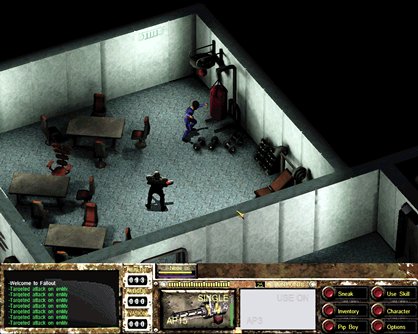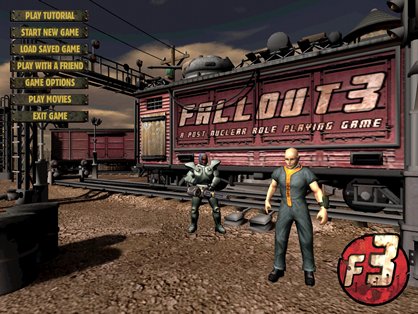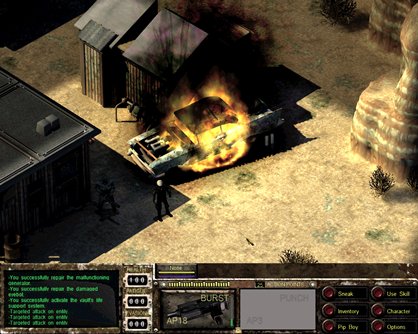The lost PC games you'll never play
Witness the last gasp of potentially great canceled games
Forged in the irradiated offices of Black Isle before parent-publisher Interplay wielded the axe on its most precious possession, Van Buren was the name of Fallout 3 before the license was sold to Bethesda.

Fascinatingly, a fair amount of concepts and content from Van Buren are now being integrated into Obsidian’s Fallout: New Vegas – where many of the original Black Isle developers are now shacked up.
Caesar’s Legion slavers, who in New Vegas are making a mess of the Strip, were first a part of Van Buren – while locations such as the Hoover Dam (in Van Buren an area where you could start a town and populate it with NPCs from elsewhere in the game world) are central in both games.
Van Buren had you awake as a prisoner undergoing analysis by a mysterious AI known as Odysseus, at least a generation after the unconnected events of Fallout 2, and rescued by New California Republic troops who are embroiled in a war with the religious tech warriors of the Brotherhood of Steel.
“Van Buren was built on the same technology we were going to use for Baldur’s Gate 3,” explains Van Buren’s story designer Sean K Reynolds. “You’d have multiple controllable NPCs that you could recruit into your party including a tribal, a Mr. Handy in need of repair, a ghoul, and a smart dog. All of them had scripts that would change their behaviour based on what you said to them, what you did, and what other characters joined the group. There was even a way to put a companion NPC’s brain into a robot’s chassis and have it continue to be in your party – though you’d have to mindwipe it or it would kill you the first chance it got.”

The game (a tech demo of which can be downloaded fromnma-fallout.com) was familiar Fallout in appearance – yet allowed the camera to spin through a full circle to fully admire the popping of heads, and allowing for better designed combat areas than previous Fallouts. Ask for the developers’ favourite moments from the dead game though, and you’re in for a barrage of cruel nostalgia.
“It’s hard to choose!” sighs Reynolds. “Finding the ghouls’ attempts to birth more of their kind the old-fashioned way. Realising why everyone in the game is getting sick. Your mindwiped, brainbotted buddy who keeps whispering murderous things. Using a StealthBoy and watching it erode the player’s sanity until the game started playing tricks on what they saw, from distorted areas on the map to creatures that weren’t really there.
"Fixing up the motorcycle, or the cop car, or the truck, or the 18-wheeler, and how the various NPCs would pile in or onto it when you’d start driving – your Super Mutant teammate would cram himself into the motorcycle’s side car, for example. And, of course, the very end scene, where the player has won a Pyrrhic victory and isn’t sure of his own survival when the game ends.”
Weekly digests, tales from the communities you love, and more

So what of the new breed of Fallout? What did one of the men behind the original wasteland sequel make of Vault Boy’s capitol adventure? “I haven’t played it,” states Reynolds. “No knocks to Bethesda, everyone I know who’s played says it’s a great game, but thinking about playing their Fallout 3 just makes me think of the unfinished Van Buren and the stupidity and greed of Interplay’s upper management that killed it.”
The end
History gave us Fallout 3, and then a benevolent God conspired to cook up Fallout: New Vegas. Proof positive that the falling of the production axe doesn’t automatically mean an unhappy ending. For most of us, anyway.
Status: Reincarnated, though to what extent is as yet unclear.
The Crossing
In development: 2006-2009 (on hold)
Developer: Arkane Studios
A few years ago Arkane Studios, creators of Dark Messiah of Might & Magic, dazzled the PC gaming press with visions of blue skies, leaping Templars and a remarkable blend of modern Parisian and ancient gothic architecture.
Even more intriguing was the promise of CrossPlay: placing human players as enemies within the single-player campaign. Letting deathmatch bouts run riot around you as you move through story missions would have shattered the very fabric of multiplayer as we know it. But then, at the start of 2009, the news came that The Crossing had been put on hold. Arkane CEO and Studio Director Raphael Colantonio explains why.
The Crossing was hotly anticipated. Why did Arkane have to put it on hold?
Being an independent developer has great advantages as you can do the games you want, but it has a constraint too: money!
We self-funded enough of the game that we could demo it to potential publishers. However, of the proposals we had, we never managed to reach an agreement that we felt was fair. Having been burnt in the past under similar situations, we decided to not do the game until all the conditions for doing it right were met. This happened at the same time as another publisher invited us to work on a very sexy game with good financial terms, so the choice became obvious.

How far into development did you get with the game? Did you have a playable build?
We had a playable demo that showcased the fun and the structure of the game. We had one mission worth about 20 minutes of play. You could play single-player or against one to four real players dropping in or out. Is it fun? Yes. Very fun. Every time we play it, we feel a little pinch inside, because it reminds us how much fun this game will be if it ever gets made. At some point we thought “What if we just released the demo to the public as it is?” then we realized there would be tons of support and legal issues stuff, so we never bothered.
Since The Crossing was announced have you seen anything like CrossPlay in other games?
There have been a number of games that I can think of that shipped and have touched on similar premises of CrossPlay, but with different takes on it: Left 4 Dead is one for sure (asymmetrical co-op team play in a single-player type map layout with sequential objectives). Brink is another one and I bet there will be more.
Some of the concept is still untouched though: the way we handled narratives, the progression of the single-player hero in a structure that would make abstraction of multiplayer or single-player considerations, and more.
The Crossing was announced at the end of 2006, and much has changed in gaming since then. If it were put back into development how do you think your plans would change?
Well, graphic assets would have to be redone at this point, since as you say, it’s been a while. However, the hardest part is done with the demo, not that every hurdle is out of the way, but proving the fun is usually the hardest part.
As far as changing plans: yes, of course, since game design is something that evolves according to current trends and fashions, but we’re mostly talking about details in the big picture.

What with Arkane busying themselves with other projects, how likely do you think it is that The Crossing will return?
It’s a possibility. We’re really happy with how things turned out for us since then: our collaboration on BioShock 2 along with some other stuff. I’m also co-directing the game of my dreams with Harvey Smith [lead designer on seminal classic Deus Ex] now, so who knows?
The end
Maybe not. The heart of The Crossing beats on, even if we’ll have to wait a long time to see if it ever reawakens from its slumbers.
Status: Not quite dead.


